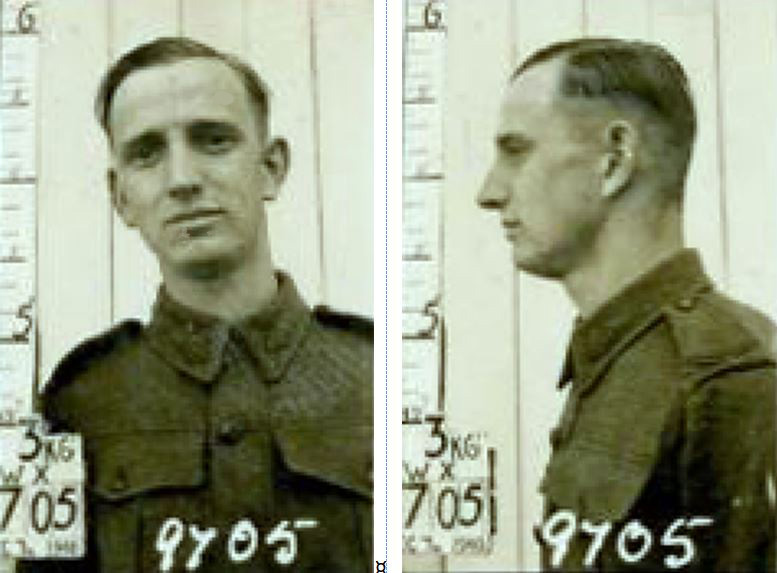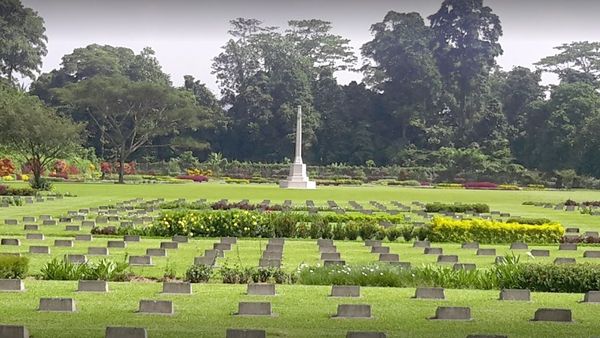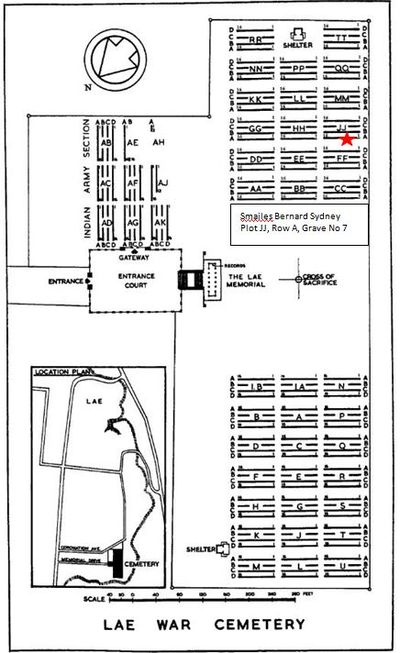Bernard Sydney Smailes
From Our Contribution
 | |
| Personal Information | |
|---|---|
| Date of Birth | 6 Mar 1920 |
| Place of Birth | Perth, Western Australia |
| Death | 22 Nov 1943 |
| Place of Death | Pabu, near Finschafen, New Guinea |
| Age at Enlistment | 20 years, 9 months |
| Occupation | Timber worker |
| Religion | Church of England |
| Address | Karragullen, Western Australia |
| Next of Kin | Father , Mr. Sydney Smailes |
| Military Information | |
| Reg Number | WX9705 |
| Date of Enlistment | 6 Dec 1940 |
| Rank | Corporal |
| Unit/Formation | 2/32nd Australian Infantry Battalion |
| Post War Details | |
| Monument(s) | WA State War Memorial |
| Australian War Memorial | Australian War Memorial |
| Medals |
1939-45 Star Pacific Star Defence Medal War Medal 1939-45 Australian Service Medal 1939-45 |
Pre War
War Service
Bernard enlisted in the 2nd AIF on 6 Dec 1940 at the Claremont Showgrounds and was sent to the Naval Base Training Depot on 10 Dec 1940. He was admitted to the Naval Base Camp Hospital for treatment for Urethrites on 7 Jan 1941 and was released back to his unit on 14 Jan 1941. On 21 Jan 1941 Bernard was transferred to the No 1 Training Battalian at Northam Camp, but a week later on 29 Jan 1941 Bernard was again hospitalised, this time in the Northam Camp Hospital, before being passed to the 110th Australian Base Hospital which diagnosed VD on 30 Jan 1941. He was released to duty on 21 Feb 1941 having had 22 days ineffective service. On 25 Feb 1942 Bernard was transferred to the 13th Australian Infantry Training Battalion, to train as a member of the 10th Reinforcement draft for the 2/11th Australian Infantry Battalion. On 17 Apr 1941 this changed as he was transferred to the 5th Reinforcement draft for the 2/32nd Australian Infantry Battalion where on 6 Jun 1941 he was made an Acting Lance Corporal.
Granted pre-embarkation leave from 24 - 30 Apr 1941 Bernard embarked in Fremantle on 5 Jul 1941 aboard HMT Aquitania which with the Queen Mary and Queen Elizabeth constituted Convoy US 11A. They refueled in Colombo and Trincomalee enroute to Port Tewfik in Egypt where they disembarked on 25 Jul 1941. On 31 Jul 1941 Bernard reverted to Private before transferring on 13 Aug 1941 to the AIF (Middle East) Signals Training Battalion. Signals training completed, on 24 Sep 1941 Bernard was posted to the 25th Australian Infantry Training Battalion, and eventually on 4 Oct 1941 Bernard joined the 2/32nd Australian Infantry Battalion. From 30 May until 27 June 1942 he was detached to the HQ 24th Australian Infantry Brigade, and on 7 Jul 1942 he was graded as a Group II Signaller. Admitted to the 2/8th Australian Field Ambulance on 17 Oct 1942, they passed him on to the 10th British Casualty Clearing Station on 20 Oct 1941 diagnosed with Infantile Hepatitis. On 30 Oct 1942 Bernard was released to the 2/4th Australian Convalescent Depot which returned him to his battalion on 12 Nov 1942.
On 24 Jan 1943 Bernard and his unit boarded HMT Queen Mary (known as HMT L1) along with the 2/3rd Australian Pioneer Battalion, the 2/28th Australian Infantry Battalion and the 2/43rd Australian Infantry Battalion. Western Australian personnel disembarked in Gauge Roads on 18 Feb 1943 for leave before leaving Perth on 6 Apr 1943 to rejoin the battalion in North Queensland. During his leave, Bernard took the opportunity to marry Bernice Eileen Hanabury on 22 Mar 1943. On 28 May 1943 Bernard was appointed Lance Corporal and on 7 Aug 1943 the battalion embarked on USAT Charles P. Steinmetz in Cairns for Milne Bay in New Guinea where they disembarked on 10 Aug 1943. On 12 Oct 1943 Bernard was promoted Acting Corporal, and during the night of 22/23 Nov 1943 he was Killed in Action when his company were heavily attacked by the enemy who cut them off from the rest of the battalion.
Re-organised for jungle operations, the 2/32nd participated in the 9th Division's amphibious landing at Red Beach, north-west of Lae. While the division's other brigades had landed on 4 September, the 24th Brigade came ashore during the night of 5 September. The 2/28th and 2/43rd went into the fighting around Lae but the 2/32nd, which had been the divisional reserve, did not take part in the fighting until 14 September when they were patrolling areas north of Lae near Sattelberg.[1]
Notes
- ↑ The Australian War Memorial webpage; 2/32nd Australian Infantry Battalion

